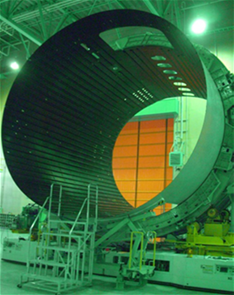Design of Modern Aircraft Structures

Instructed by Dr. Michael Mohaghegh, Boeing Technical Fellow: Advanced Structures and Materials
- This applied introductory course covers the most important fundamental and practical concepts of modern aircraft structures.
- Course will also include illustrative application examples, practice exercise problems, and supplemental material to enhance the learning experience
- At the conclusion of the course, students may choose to complete an optional design project to test what they’ve learned.
- All students will receive an AIAA Certificate of Completion at the end of the course
OVERVIEW
The course starts with a proposed set of desired competencies for both design and analysis. The course then covers evolution of design philosophy; airframe configurations and load paths; trade studies; margin of safety concept; material selection, design values; failure theories; idealization, using structural elements; selection of classical, empirical, and finite element analysis methods. This course also includes selected topics in design of structures under tensile, compressive, shear, and combined loads, and design of joints, fittings, and lugs. An introduction to design for fail-safety, durability, and damage tolerance is also presented. The course includes practice problems and an optional design project.
The course material has been reviewed and endorsed by the AIAA Structures Technical Committee.
LEARNING OBJECTIVES
- Explain the design and analysis competencies of aircraft structures
- Describe examples of airplane component configurations and load paths
- Describe design criteria and its evolution
- Explain the importance of trade studies for optimization
- Explain the verification, validation and certification process
- Identify design drivers for various components
- Describe how to develop or select material for an airplane part or component
- Be able to explain the simplification of the three-dimensional stresses and strains for structural elements including rods, beams, plates, and shells.
- Describe selection of analytical, empirical or finite element methods
- Recognize metals and composites strength and weaknesses for various applications
- Explain failure theories under combined stresses
- Describe the margin of safety concept
- Describe design for durability, fail safety and damage tolerance
KEY TOPICS
- Structures Competencies
- Configurations
- Freebody Diagrams and Load Paths
- Design Philosophy and Criteria
- Verification, Validation, Qualification and Certification
- Materials
- Design Allowables and Values
- Material Selection
- Idealization and Analysis Methods
- Joints, Lugs and Fittings
- Fatigue and Fracture
- Floor Structure Design Project
See detailed lecture-by-lecture outline below
EXERCISE PROBLEMS
- Margin of Safety
- Combined Stresses
- Airframe Configuration
- Design Criteria, Validation and Testing
- Analysis Methods
- Material Selection
- Load Paths
- Structural Elements
- Joints, Lugs and Fittings
- Fail safety, Fatigue and Fracture
- Floor Structure Design Project
WHO SHOULD ATTEND
This course is for those industry and government engineers in airplane design, analysis, support, certification, as well as manufacturing or fleet support engineers. Aerospace, mechanical, civil and materials engineers would most benefit from this course.
It would also be of interest to students, practicing engineers working in the design, analysis or support functions, professors and those who wish to receive an exposure or deepen their understanding of aircraft structures engineering tools, processes, and methods.
Type of Course: Instructor-Led Short Course
Course Length: 2, 3, or 4 days
AIAA CEU's available: Yes
This course is also available on-demand.
Lecture 1 - Structures Competencies
- Introduction and background
- Course schedule
- Structures Engineer’s Competencies
- Design competencies
- Analysis competencies
Lecture 2 - Load Paths
- FBDs for airplane, components and elements
- Method of sections for internal loads
- Idealization and boundary conditions
- Efficient load paths for airplane components
Lecture 3 - Design Philosophy
- How the requirements affect design
- Various agencies and regulations
- The evolution of design requirements
- The 10 major design requirements
- Design drivers
- Building Block Approach
- Qualification
- Certification
Lecture 4 – Materials
- Metals
- Composites
- Design allowables and values
- Material Selection
Lecture 5 - Lecture 7 - Idealization and Analysis Methods
- Structural elements
- Classical empirical and FEA methods
- Advantages and limitations of the methods
- Examples of airplane structural analyses
Lecture 6 - Margin of Safety Concept
- Factor of safety (FOS) and margin of safety (MOS)
- Process for finding the MOS
- Relationship between FOS and MOS
- Local vs far field stresses
- Examples of MOS
Lecture 7 - Failure Theories
- Failure Criteria for metals
- Combined loading
- Failure Criteria for composites
Lecture 8 - Fasteners, Joints, Lugs and Fittings
- Types of fasteners
- Types of joints
- Analysis of joints
- Analysis of lugs
- Analysis of fittings
Lecture 9 - Durability, Fail Safety and Damage Tolerance
- Design for durability
- Design for fail-safety
- Design for damage tolerance
Design Project (Optional)
Michael Mohaghegh has worked for The Boeing Company for 50+ years on programs, core groups, product development, commercial and military aircrafts, and aircraft support groups. He is a Boeing Technical Fellow in aircraft structures and materials and presently the Chief Editor of The Boeing Company Design Principles Manuals. Mike is an affiliate faculty member in the Department of Aeronautics and Astronautics and is the Director of Modern Aircraft Structures Certificate Program at the University of Washington. He graduated from the University of California (Berkeley) with a BS and MS and from University of Washington with a PhD in Civil Engineering with focus in Structures Engineering. He was also a post doc for 2 years doing research in Failure Analysis at the University of Washington. He has published numerous papers and developed and taught many courses in aircraft structures at Boeing, DoD, airlines, suppliers, and MROs. He was the lead author for the chapter on Subsonic Aircraft Materials in AIAA’s book on Aerospace Materials published in 2017.
AIAA Training Links
For information, group discounts,
and private course pricing, contact:
Lisa Le, Education Specialist (lisal@aiaa.org)
